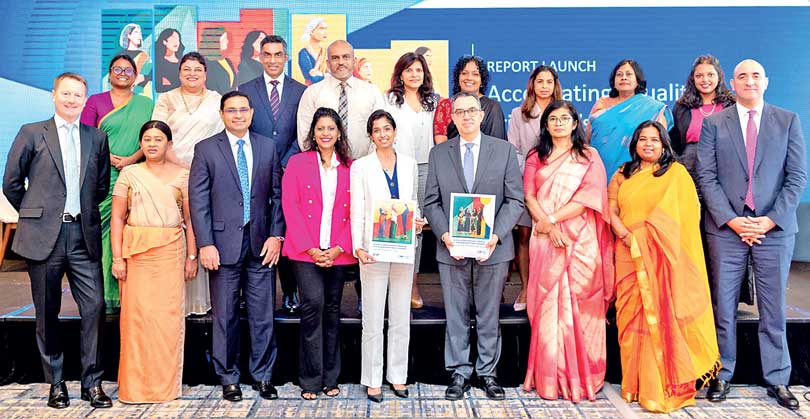Friday Apr 18, 2025
Friday Apr 18, 2025
Tuesday, 4 June 2024 00:24 - - {{hitsCtrl.values.hits}}

IFC’s Regional Director for South Asia Imad N. Fakhoury (third from right) with representatives of banking sector at launch of report
A new International Finance Corporation (IFC) report reveals that Sri Lanka surpasses regional counterparts in recruiting women at the entry-level in the banking sector, with women comprising 46% of new recruits.
The report, supported by the Women in Work program—a partnership between IFC and the Australian government—also highlights Sri Lanka’s leadership in board-level gender diversity, with women holding 27% of board positions, compared to 20% in Nepal and 14% in Bangladesh.
The pioneering report, Women’s Advancement in Banking in Emerging South Asian Countries, aims to optimise opportunities that enable women to advance to senior roles in the banking industry across South Asia. This multi-country study, among the first of its kind in the region, focuses on private-sector commercial banks in Bangladesh, Nepal, and Sri Lanka, where women constitute 30% of the banking workforce compared to the global average of 52%.
Research conducted across seven leading private commercial banks in Sri Lanka, representing 41% of the market share, forms the basis of insights on Sri Lanka.
While Sri Lanka’s banking industry is close to achieving parity in hiring women and is considerably ahead of other countries in terms of women’s share in the workforce, women’s progression does not match their career aspirations or progression rates for men. Representation drops from 40% at entry-level to 27% in middle management and further to 20% in senior management roles.
“Investing in the potential of women leaders isn’t just about equality, it’s about unlocking the full spectrum of talent and driving sustainable growth–exactly what Sri Lanka needs for a resilient economic recovery,” said IFC Regional Director for South Asia Imad N. Fakhoury. “Addressing the multifaceted challenges faced by female bankers requires comprehensive and collective action, rather than isolated interventions. We must tackle these barriers—whether policy, process, or culture–related—in a targeted manner, creating an inclusive banking sector and driving greater economic growth.”
The report underlines how barriers such as lack of fair evaluations, sociocultural constraints and non-conducive work environments curtail women’s growth prospects in the Sri Lankan banking industry. While banks and policymakers have initiated several steps to improve women’s participation and career progression, stronger commitment from leadership is essential to create inclusive workplaces. The report reveals scepticism among many employees, including senior leaders and more than 50% of middle managers, regarding the importance of female leadership for businesses to be competitive.
Previous research indicates that commercial banks with at least 15% of women in senior management achieve up to 33% higher return on equity. A growing body of evidence further links an increase in women’s representation in organisations to better performance on business metrics.
“This comprehensive, data-based report is a strong starting point for the banking sector to improve long-term policies allowing women and men to achieve their potential. The sector – as well as other organisations – should take note of findings that show an increase in women’s representation in senior manager or higher roles delivers higher returns and stronger business outcomes,” said Australian High Commissioner for Sri Lanka Paul Stephens.
The report also recommends targeted efforts in Sri Lanka to bolster women’s participation and advancement in commercial banking. These include establishing organisational commitment and accountability for gender diversity, building equitable and safe workplaces, and developing supportive ecosystems, networks, and professional development opportunities. These findings and recommendations aim to guide industry actors—C-suite leaders in commercial banks, policymakers, industry bodies, and investors—towards increasing women’s representation in leadership in the banking industry.
Discover Kapruka, the leading online shopping platform in Sri Lanka, where you can conveniently send Gifts and Flowers to your loved ones for any event including Valentine ’s Day. Explore a wide range of popular Shopping Categories on Kapruka, including Toys, Groceries, Electronics, Birthday Cakes, Fruits, Chocolates, Flower Bouquets, Clothing, Watches, Lingerie, Gift Sets and Jewellery. Also if you’re interested in selling with Kapruka, Partner Central by Kapruka is the best solution to start with. Moreover, through Kapruka Global Shop, you can also enjoy the convenience of purchasing products from renowned platforms like Amazon and eBay and have them delivered to Sri Lanka.
Discover Kapruka, the leading online shopping platform in Sri Lanka, where you can conveniently send Gifts and Flowers to your loved ones for any event including Valentine ’s Day. Explore a wide range of popular Shopping Categories on Kapruka, including Toys, Groceries, Electronics, Birthday Cakes, Fruits, Chocolates, Flower Bouquets, Clothing, Watches, Lingerie, Gift Sets and Jewellery. Also if you’re interested in selling with Kapruka, Partner Central by Kapruka is the best solution to start with. Moreover, through Kapruka Global Shop, you can also enjoy the convenience of purchasing products from renowned platforms like Amazon and eBay and have them delivered to Sri Lanka.